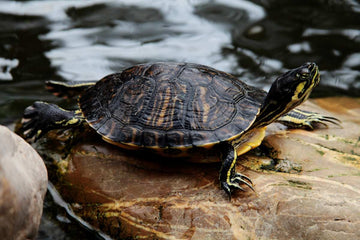
Setting up a turtle tank is more than just filling it with water and calling it a day. Turtles need both swimming and basking areas to thrive in their environment. Creating a habitat that recreates their natural surroundings is essential for their health and well-being. From providing a spacious area to swim to a dry, warm spot for basking, each component plays an essential role in keeping your turtle happy and healthy.
Whether you’re a first-time turtle owner or looking to upgrade your setup, this guide will walk you through the essentials of building a successful turtle tank.
Key Takeaways
- Setting up a turtle tank involves more than just adding water; turtles need both swimming and basking areas to thrive. A well-designed tank that mimics their natural habitat is essential for their health and well-being.
- Key components like a filtration system, heat lamps, and temperature regulation are crucial to maintaining a healthy environment. Proper tank size, clean water, and basking spots are essential for your turtle’s comfort and growth.
- Gotta Go Grass®, natural grass pads for reptiles, provide a natural, easy-to-maintain substrate that aids humidity control, supports shedding, and adds comfort to your turtle’s habitat.

1. Tank Size and Space Requirements
A key factor in setting up a turtle tank is selecting the appropriate size. Turtles are active creatures that require plenty of space to swim, bask, and explore. Turtle sizes vary depending on the breed, so research the specific needs of your turtle. A general rule is that the tank should have at least 10 gallons of water for every inch of the turtle’s shell. For example, a turtle with a 4-inch shell needs at least a 40-gallon tank. Some species, like red-eared sliders, can grow quite large, so planning for their adult size is essential. Some owners start with a tank that accommodates their turtle's full-grown size, while others prefer to start small and expand the setup as their turtle grows.
In addition to the water area, turtles need a dry land area to bask and rest. This land-to-water balance helps replicate their natural environment and provides opportunities for swimming and basking, which are critical to their well-being.
2. Water Filtration System
Turtles can be quite messy, and maintaining clean water is essential to their health. Without proper filtration, the water can quickly become dirty, leading to harmful bacteria and ammonia buildup. To keep up with their waste, it's recommended to invest in a reliable filtration system with a filter designed for tanks twice the size of your actual tank volume.
Along with a good filter, regular water changes are necessary to maintain water quality. A partial water change of about 25-50 percent of the tank water weekly helps keep the environment healthy and toxins-free. Ensure that uneaten food is removed and the basking area is cleaned every week to prevent the buildup of bacteria and debris.
Additionally, regularly test the water to monitor pH levels, ammonia, nitrites, and nitrates. Aim for a pH level between 6.5 and 8.0. High levels of ammonia and nitrites can be harmful, so testing kits should be part of your routine maintenance. Using a water conditioner to remove chlorine and chloramines from tap water is also essential when filling or refilling the tank.
3. Basking Area and Heat Lamps
Turtles need a dry, warm basking area to maintain their body temperature and health. Basking helps regulate their metabolism, digest food, and keep their shells healthy. A turtle tank should have a platform above the water where the turtle can completely dry off and bask under a heat lamp. The basking area should be positioned under UVA/UVB light, which replicates natural sunlight and is essential for calcium absorption and strong shell growth.
For turtles, it's important to provide a temperature gradient, with the basking area being warmer than the water. The basking spot should reach temperatures between 85°F and 90°F, while the water should be kept at around 75°F to 85°F, depending on the species.
4. Substrate and Flooring Options
Sand, gravel, and soil are commonly used as substrates or flooring for turtle tanks. But another excellent alternative for creating a more natural environment is Gotta Go Grass® for reptiles.
These grass pads for reptiles provide a nature-inspired solution with a 16x24-inch natural grass surface grown in healthy soil. They bring a touch of the outdoors to your turtle's tank, helping it feel like a true natural habitat. They add comfort and help maintain optimal humidity levels, which is essential for preventing shell issues and aiding in shedding.
Gotta Go Grass® also naturally controls odors, keeping the tank fresher for longer periods. The pet-safe, interlocking trays allow you to customize the grass pad to fit any tank size. With minimal maintenance—occasional misting and exposure to sunlight—Gotta Go Grass® can last up to four weeks, making it an excellent addition to your turtle's enclosure.
5. Heating and Temperature Regulation
Temperature regulation is crucial for a turtle’s health, as they rely on external heat sources to regulate their body temperature. The water in the tank should be maintained at a steady temperature, usually between 75°F and 85°F, depending on the turtle species. You can use a submersible water heater to maintain the proper temperature.
Meanwhile, the basking area should be kept at around 85°F to 90°F, which can be achieved with a heat lamp. To ensure that the temperatures stay consistent, consider using a thermostat to monitor and adjust both the water and air temperatures in the tank. Providing your turtle with a proper temperature gradient allows them to move between warm and cool areas, mimicking their behavior in the wild.
6. Plants and Decorations
In addition to the Gotta Go Grass® pad as a substrate, adding plants and decorations to the turtle tank serves aesthetic and practical purposes. Live or artificial plants create hiding spaces and provide shade, helping turtles feel secure. Decorations like rocks, driftwood, and logs can also give your turtle places to explore and rest. When adding decorations, ensure that they are smooth and free of sharp edges that could injure your turtle.

Final Thoughts
Setting up a turtle tank that mimics your pet’s natural habitat is essential for their long-term health and well-being. From the right tank size to proper lighting and heating, each component plays a crucial role in ensuring your turtle thrives. Gotta Go Grass® for reptiles is a perfect addition to any turtle tank, providing a nature-inspired, easy-to-maintain solution that benefits you and your pet. By following these tips, you’ll create a happy, healthy environment that your turtle will love.
Learn more about our wide range of pet-friendly solutions, like grass pads for dogs and other products, at the Gotta Go Grass® website today.




